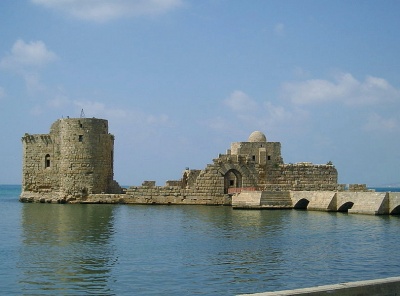Crusades and Crusaders
Date posted
I always find it erie and strange to travel in countries in the south and come across vestiges of Western culture, almost invariably better known as Western imperialism. Be it slave castles in Western Africa, or churches and other religious structures in South Asia and elsewhere. Missionaries can be understood also as crusaders, on a mission from God. While missionaries aimed to convert the infidels, crusaders wanted to kill the very same infidels that had invaded the promised land. These two categories certainly had objectives that were overlapping. Once, in a church in Aden, Yemen, I saw a Norwegian bible (sic). This is a good example of how the crusades, or rather the long-term effects of the crusades, whether it was to kill or to baptize, are still visible and felt.
And now to crusader castles in Lebanon. I traveled throughout Lebanon in October 2017, and visited Sidon and the Sea Castle (Wikipedia n.d.a; Wikipedia n.d.b). Sidon is a coastal city in Lebanon's South Governorate, and was once a bcoastion of the Phoenicians. The Sea Castle was built on a small island in the 13th century by crusaders (possibly built on top of earlier Phoenician structures). At the time it must have been an impressive and beautiful structure. However, over the centuries, with each new ruler, be it Mameluks or Ottomans, it was destroyed and rebuilt several times. Today little is left of the original structure. It was kind of strange to walk around there. I mean, the crusaders were Europeans, they were Christians, they were in a sense my cultural ancestors, if that is not drawing the parallel too far.
And now consider this: In the aftermath of the first crusade in AD 1095, the Norwegian King Sigurd I Magnusson (aka Sigurd the Crusader) organized a crusade in the period AD 1107-1111, with maybe around 5,000 men that sailed in some 60 ships (Wikipedia n.d.c). This was the first time a Europan king personally traveled to the Holy Land. While there, King Sigurd took part in a siege of, guess what, Sidon! My ancestors were in Sidon more than 900 years ago. Imagine that!
At any rate, the crusades and crusaders are long gone. They were nothing but another early Western idea of conquest, based on faulty imperialistic notions about the Levant, its ethnic and religious make-up and history, and it was executed in a bad way. The whole adventure lasted all of around 200 years, beginning with the first crusade in AD 1095 and ending with the fall of the last Christian outposts in AD 1291. It left nothing but havoc on the local cultures. And the local people continue to pay, in various ways, to this very day.
Lars T Soeftestad
Notes
(1) Image credit: Heretiq, Wikimedia Commons user. Sidon Sea Castle. Licensed under the Creative Commons Attribution-Share Alike 2.5 Generic license.
(2) Permalink. URL: https://devblog.no/en/article/crusades-and-crusaders
(3) This artice was published 22 June 2018. It was revised 5 November 2019.
Sources
Wikipedia. n.d.a. "Crusades." URL: https://en.wikipedia.org/wiki/Crusades
Wikipedia. n.d.b. "Sidon Sea Castle." URL: https://en.wikipedia.org/wiki/Sidon_Sea_Castle
Wikipedia. n.d.c. "Norwegian crusade." URL: https://en.wikipedia.org/wiki/Norwegian_Crusadehttps://en.wikipedia.org/wiki/Norwegian_Crusade
